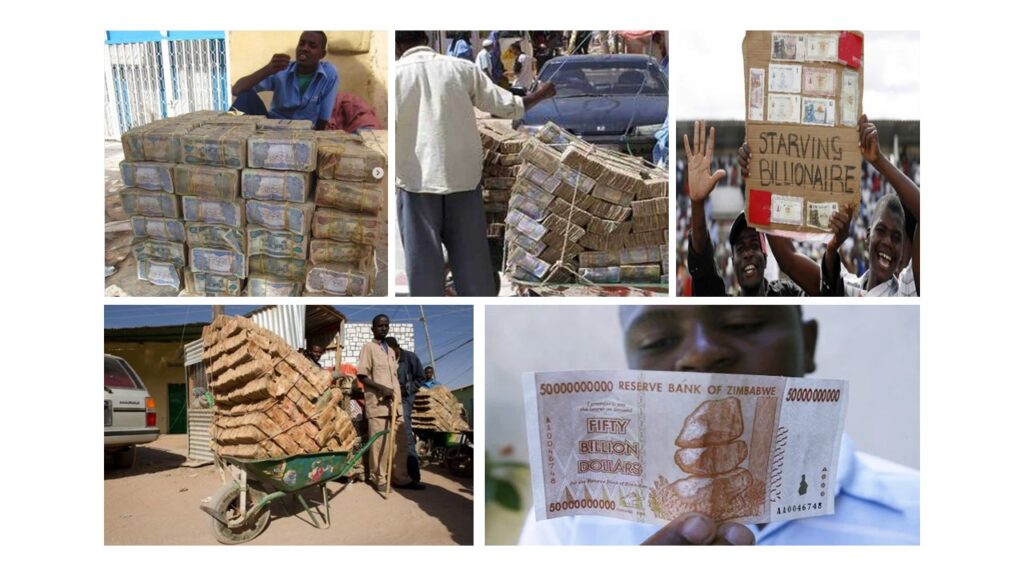In the late 2000s, Zimbabwe experienced a financial rollercoaster that shook the nation to its core. This tumultuous period, marked by jaw-dropping hyperinflation, left its citizens grappling with economic chaos. In this blog post, we’ll take a closer look at the Zimbabwe Hyperinflation of 2008-2009, using straightforward language to unravel the complexities of this challenging time.


The Root of the Storm: Economic Turmoil and Mismanagement
Before the hyperinflation storm hit, Zimbabwe faced economic challenges fueled by political unrest and mismanagement. The government printed an excessive amount of money, and this oversupply of cash triggered a chain reaction that led to hyperinflation.
The Crazy Numbers: Zimbabwe’s Astronomical Inflation Rates
To understand the scale of the problem, let’s talk numbers. In 2008, Zimbabwe’s inflation rate soared to a mind-boggling 79.6 billion percent. Yes, you read that right—79.6 billion! Prices were doubling every 24 hours. Imagine buying a loaf of bread today and finding out it costs twice as much tomorrow, and then double that the next day. It was like trying to catch a runaway train.
The Trillion-Dollar Notes: Money That Couldn’t Keep Up
As inflation skyrocketed, the value of the Zimbabwean dollar nosedived. To cope with the ever-growing prices, the government introduced higher and higher denominations of currency. At the peak, the Reserve Bank of Zimbabwe issued one hundred trillion-dollar notes. Yet, these notes became more like collector’s items than practical currency as they couldn’t buy much in the real world.


Everyday Struggles: The Impact on People’s Lives
The hyperinflation nightmare wasn’t just about big numbers on paper. It had a direct impact on people’s lives. Ordinary citizens found their savings evaporating, pensions becoming worthless, and the basic cost of living becoming an unbearable burden. There were instances where the cost doubled or even tripled within a 24-hour period. At one point, a loaf of bread was Z$550,000,000 in the regular market, when bread was even available.
A Currency Circus: Foreign Currencies to the Rescue
With the Zimbabwean dollar losing its value faster than you could blink, the government had to take drastic measures. In 2009, the country officially abandoned its own currency, and foreign currencies like the US dollar and the South African rand became the go-to money. It was a symbolic farewell to the once-mighty Zimbabwean dollar.
Key Reasons Behind the Zimbabwe Hyperinflation
- Printing Too Much Money: The government printed a lot of money without having enough valuable things like goods and services to back it up.
- Political Choices: The government made some bad decisions, like taking away land from farmers without knowing much about farming. This hurt the country’s ability to produce enough food.
- Loss of Trust: People lost trust in their money because its value was going down so quickly. When people don’t trust money, they try to get rid of it as fast as possible by buying anything they can, which makes prices go up a lot.
- Economic Problems: The country had economic problems, and because of that, businesses struggled. When businesses struggle, people lose jobs, and the whole economy gets shaky.
- Lack of Information: The government didn’t give out good information about what was happening. Without accurate information, it’s hard for people and businesses to make smart decisions.
Important Lessons to Learn from the Zimbabwe Hyperinflation
The Zimbabwe Hyperinflation of 2008-2009 serves as a cautionary tale for investors, offering several important lessons. Here are some key takeaways:
- Impact of Hyperinflation:
- Hyperinflation can have devastating effects on an economy. During this period in Zimbabwe, prices were doubling every 24 hours, leading to a collapse of the currency and severe economic hardships for citizens.
- Investors need to be vigilant about the economic stability of the countries in which they invest. Hyperinflation can erode the real value of investments rapidly.
- Political and Economic Mismanagement:
- The hyperinflation in Zimbabwe was largely a result of political and economic mismanagement, including land reform policies and excessive money printing.
- Political stability and sound economic policies are crucial for long-term investment success. Investors should carefully assess the political and economic climate of a country before committing funds.
- Diversification is Key:
- Over-reliance on a single asset class, especially when it’s tied to a specific currency, can be disastrous. In Zimbabwe, the hyperinflation wiped out the value of the local currency and investments tied to it.
- Diversification across asset classes, geographies, and currencies can help mitigate risks. Holding a mix of assets that respond differently to economic conditions can provide a buffer during turbulent times.
- Importance of Currency Risk Management:
- Currency risk can be a significant factor in international investments. In Zimbabwe, the rapid depreciation of the currency led to immense losses for investors.
- Hedging strategies and careful consideration of currency risk are essential when investing globally. Investors should be aware of the potential impact of currency fluctuations on their portfolios.
- Need for Independent and Reliable Information:
- During the hyperinflation period, accurate economic data and information were often lacking or manipulated, making it challenging for investors to make informed decisions.
- Access to reliable information is crucial for investment decisions. Investors should seek out independent sources of information and be cautious about relying solely on government or biased reports.
- Inflation Hedge Investments:
- Investments that traditionally act as hedges against inflation, such as precious metals and real assets, can play a role in preserving wealth during hyperinflationary periods.
- Consider including inflation-resistant assets in a diversified portfolio. Assets like gold, real estate, or inflation-protected securities may help preserve purchasing power in the face of rising inflation.
- Adaptability and Monitoring:
- Economic conditions can change rapidly, and investors need to be adaptable and continuously monitor their investments.
- Regularly reassess your investment strategy, taking into account changes in economic conditions, government policies, and global events. Being proactive and making adjustments as needed can help protect your portfolio.
In wrapping up, you can take away some important lessons from Zimbabwe’s hyperinflation. Stay alert to economic changes, be aware of warning signs, and spread your investments wisely. Learning from this history can help you make smart choices and protect your money in unpredictable times.









Incredible! The article is quite well written, and reading it has provided me with a great deal of insight.
Thanks I have recently been looking for info about this subject for a while and yours is the greatest I have discovered so far However what in regards to the bottom line Are you certain in regards to the supply
Hi i think that i saw you visited my web site thus i came to Return the favore I am attempting to find things to improve my web siteI suppose its ok to use some of your ideas
Ive read several just right stuff here Certainly price bookmarking for revisiting I wonder how a lot effort you place to create this kind of great informative website
What an eye-opening and meticulously-researched article! The author’s meticulousness and ability to present complex ideas in a digestible manner is truly commendable. I’m thoroughly impressed by the breadth of knowledge showcased in this piece. Thank you, author, for providing your expertise with us. This article has been a game-changer!
Thanks for your interesting article. Other thing is that mesothelioma cancer is generally due to the breathing of materials from mesothelioma, which is a dangerous material. It truly is commonly viewed among employees in the building industry who definitely have long experience of asbestos. It’s also caused by residing in asbestos insulated buildings for some time of time, Your age plays a crucial role, and some consumers are more vulnerable to the risk than others.
This was beautiful Admin. Thank you for your reflections.